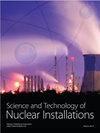氦氙混合气体在圆管内湍流和传热的数值研究
IF 0.9
4区 工程技术
Q3 NUCLEAR SCIENCE & TECHNOLOGY
引用次数: 2
摘要
气冷空间核反应堆系统通常采用氦-氙混合气体作为工作流体。由于典型的氦氙混合物的普朗特数约为0.2,低于水和空气,因此需要进一步研究氦氙混合物和其他流体之间的湍流和传热特征。本文利用ANSYS Fluent软件对氦氙混合气流(HeXe40,M = 40 g/mol,Pr = 0.21),气流(Pr = 0.71)和水流量(Pr = 6.99)。液态金属流动的直接数值模拟结果(Pr = 0.01)进行比较。结果表明,HeXe40的无量纲速度分布和边界层剪切应力与其他流体的无量纲速率分布和剪切应力接近。其他流体的经验相关性也可以很好地预测氦氙混合物的摩擦系数。由于湍流热扩散率的差异,HeXe40的无量纲径向温度分布和湍流热传导与其他流体显著不同。HeXe40的分子传导区发展到y+ ≈ 30,并且延伸到流动边界层的对数区域。此外,将氦氙混合物的可用实验Nusselt数与几种对流换热相关性进行了比较,其中Kays相关性更好。本文章由计算机程序翻译,如有差异,请以英文原文为准。
Numerical Investigation on Turbulent Flow and Heat Transfer of Helium-Xenon Gas Mixture in a Circular Tube
Gas-cooled space nuclear reactor system usually utilizes the helium-xenon gas mixture as the working fluid. Since the typical helium-xenon mixture has the Prandtl number of about 0.2, which is lower than that of water and air, the turbulent flow and heat transfer features need to be further investigated among the helium-xenon mixture and other fluids. In the current paper, numerical investigations by ANSYS Fluent are performed on helium-xenon mixture flow (HeXe40, M = 40.0 g/mol, Pr = 0.21), airflow (Pr = 0.71), and water flow (Pr = 6.99) in the circular tube. Direct numerical simulation results of liquid metal flow (Pr = 0.01) are also adopted for comparison. Results show that the dimensionless velocity profile and shear stress in the boundary layer of HeXe40 are close to those of other fluids. The empirical correlations from other fluids can also predict well the friction factor of helium-xenon mixtures. Due to the discrepancy in turbulent heat diffusivity ratio, the dimensionless radial temperature profile and turbulent heat conduction of HeXe40 significantly differ from those of other fluids. The molecular conduction region of HeXe40 develops up to y+ ≈ 30 and extends to the logarithmic region of the flow boundary layer. Moreover, the available experimental Nusselt numbers of helium-xenon mixtures are compared with several convective heat transfer correlations, in which Kays correlation is better.
求助全文
通过发布文献求助,成功后即可免费获取论文全文。
去求助
来源期刊

Science and Technology of Nuclear Installations
NUCLEAR SCIENCE & TECHNOLOGY-
CiteScore
2.30
自引率
9.10%
发文量
51
审稿时长
4-8 weeks
期刊介绍:
Science and Technology of Nuclear Installations is an international scientific journal that aims to make available knowledge on issues related to the nuclear industry and to promote development in the area of nuclear sciences and technologies. The endeavor associated with the establishment and the growth of the journal is expected to lend support to the renaissance of nuclear technology in the world and especially in those countries where nuclear programs have not yet been developed.
 求助内容:
求助内容: 应助结果提醒方式:
应助结果提醒方式:


